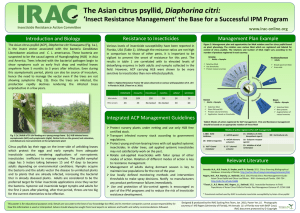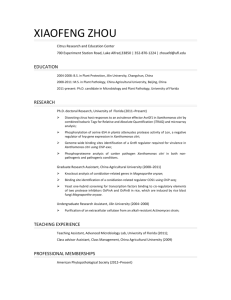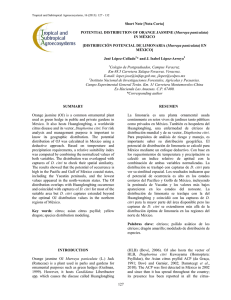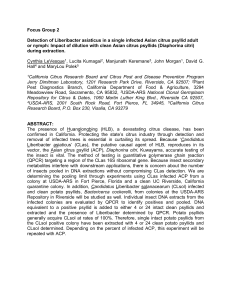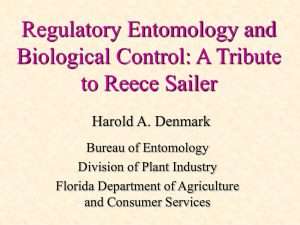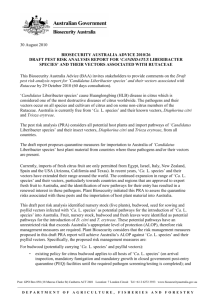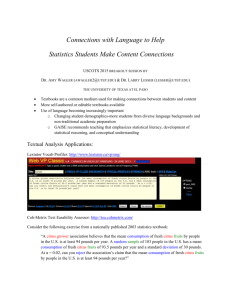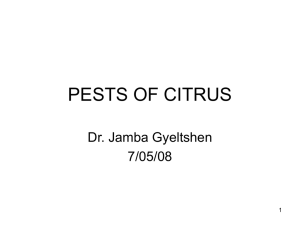Asian citrus psyllid (Diaphorina citri)
advertisement
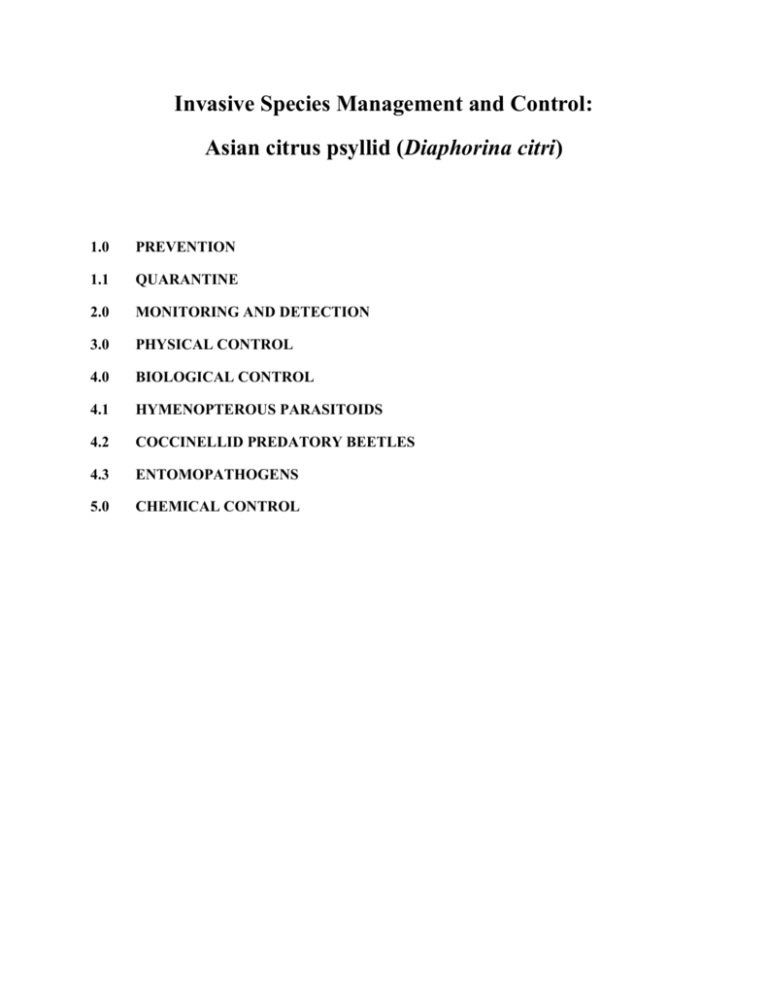
Invasive Species Management and Control: Asian citrus psyllid (Diaphorina citri) 1.0 PREVENTION 1.1 QUARANTINE 2.0 MONITORING AND DETECTION 3.0 PHYSICAL CONTROL 4.0 BIOLOGICAL CONTROL 4.1 HYMENOPTEROUS PARASITOIDS 4.2 COCCINELLID PREDATORY BEETLES 4.3 ENTOMOPATHOGENS 5.0 CHEMICAL CONTROL 1.0 PREVENTION 1.1 QUARANTINE EPPO (2005) recommends that importation of plants for planting and cut branches of citrus from countries where citrus greening bacterium or either of its vectors occurs should be prohibited. It is possible to fumigate citrus budwood material against Diaphorina citri (FAO 1983 in EPPO 2005). 2.0 MONITORING AND DETECTION Grafton-Cardwell et al. (2006) recommend that visual inspections of new flush of citrus and other potential host plants such as Murraya paniculata be carried out to monitor for D. citri infestations. Monitoring should search for eggs, nymphs and adults; although small nymphs and eggs may be difficult to see as nymphs flatten themselves around the shoot and eggs are laid inside crevices or leaf folds (Grafton-Cardwell et al. 2006). Yellow or red sticky cards are often used to monitor for adults and nymphs, but research shows that attractiveness varies according to weather conditions. Brown-yellow traps are most attractive on cloudy days, while yellow traps are most attractive on fine days. Thus it is recommended that in seasons with mostly cloudy days brown-yellow traps are used, and in seasons with predominantly sunny days yellow traps are used (Ke 1991 in Yang et al. 2006). Hall et al. (2007b) found blue traps, which had not been tested before, to be equally as effective as yellow traps. Hall et al. (2007b) also investigated tap sampling, which involves tapping an infected branch with a stick causing insects to drop onto a surface to be counted. This method was easy to conduct, and provided a good estimation of infestation. Additionally it only requires one visit, whereas setting traps and collecting them requires two visits (Hall et al. 2007b). 3.0 PHYSICAL CONTROL Reports from Vietnam indicate that citrus grown in proximity or intercropped with guava (Psidium guajava L.) were protected from D. citri. Indeed citrus groves interplanted with guava are free of D. citri, while nearby citrus groves without guava are heavily infested (Beattie et al. 2006 in Rouseff et al. 2008). It is thought that the volatiles released from the guava leaves give the repellant effect. This recent finding has sparked research into what components are responsible for the protective effect (Rouseff et al. 2008). Other recommendations to reduce incidences of D. citri in citrus orchards include establishing planting densities and canopy dimensions that minimize light intensities which favor psyllids (Chen 1987; Yang 1989 in Yang et al. 2006). Additionally the establishment of windbreaks minimizes movement of psyllids into orchards (Huang 1990; Ye 1996; Sun 1999; He 2000; Zhao 2000; Wang et al. 2002 in Yang et al. 2006). Alternative hosts of D. citri in close proximity to orchards should be removed (Ke and Xu 1990; Ke 1991; Peng et al. 1996; Sun 1999; Ma and Wang 2001; Wang et al. 2001) and ground cover plants should be cultivated to increase populations of natural enemies such as ladybirds (Chen 1988; Yang 1989; Huang et al. 1992; Zhang et al. 1996; Zhao 2000; Wang et al. 2002 in Yang et al. 2006). 4.0 BIOLOGICAL CONTROL “Natural enemies comprise entomopathogens, predators and two primary parasitoids. They cannot prevent transmission of huanglongbing but can maintain populations of the psyllid below levels that cause significant direct damage to its hosts (Liu 1989a; 1989b; Huang et al. 1999)” (Yang et al. 2006). 4.1 HYMENOPTEROUS PARASITOIDS Tamarixia dryi and T. radiata are hymenopterous ectoparasitoids of both psyllid vectors of HLB. Releases of these parasitoids have been made in a number of areas in an attempt to control psyllid populations. On Reunion Island the releases were highly effective causing significant reductions in psyllid populations and reducing damage caused by HLB (Etienne and Aubert 1980 in Qureshi et al. 2009). However in other locations the introduction of these biocontrol agents has been less successful. In Taiwan the failure of the parasitoids to control psyllids was believed to be due to hyperparasites which attack T. dryi and T. radiata (Gottwald et al. 2007). In 1999, 2000 and 2001 populations of T. radiata were released in Florida to control D. citri, although HLB was not detected until 2005. In 2006-2007 Quereshi et al. (2009) investigated the abundances and distribution of the parasitoid and host psyllid 6 years after the releases. They found that D. citri was established in all 28 citrus groves surveyed. T. radiata was found in fourth and fifth instar nymphs at 26 of the 28 locations. Parasitism was highly variable and averaged <20% in spring and summer. In autumn parasitism increased, up to a maximum of 56% in November in some locations. The authors conclude that “Additional studies on the biological characteristics of T. radiata from different geographic regions and interactions with host and predator densities could help to improve the effectiveness of this parasitoid as a biological control agent of D. citri and overall management of psyllid and citrus greening in Florida and other states” (Qureshi et al. 2009). 4.2 COCCINELLID PREDATORY BEETLES Two species of lady beetles, Olla v-nigrum and Harmonia axyridis are important natural enemies of D. citri nymphal stages in Florida (Grafton-Cardwell et al. 2006). 4.3 ENTOMOPATHOGENS In 2005 two fungal pathogens were discovered attacking D. citri in Florida. These were identified as Hirsutella citriformis and Isaria fumosorosea (Meyer et al. 2007; Meyer et al. 2008). Currently there are no fungal pesticides registered for D. citri management in Florida. Meyer et al. (2008) report that there is potential for developing I. fumosorosea (Ifr AsCP) into a microbial insecticide. Infective conidia are readily produced in vitro and D. citri nymphs were killed by Ifr As CP during a pilot field trial. Further studies are needed to compare Ifr As CP to the commercially available Ifr 97 and to test its effect on psyllid natural enemies (Meyer et al. 2008). 4.0 CHEMICAL CONTROL Chemical control of D. citri usually involves soil application of systemic insecticides such as imidacloprid and aldicarb and multiple applications (up to 8-18) of broad-spectrum foliar insecticides such as fenpropathrin, imidacloprid, abamectin, dimethoate, carbaryl, and chlorpyrifos. Insecticides are applied before foliage flushes occur, as new flushes are required for egg-laying and nymphal development (Rogers 2008 in Cocco and Hoy 2008). Systemic insecticides applied through the soil pose less risk to non-target beneficial insects and provide prolonged activity against pests. In general only nurseries and new plantings are treated with insecticides because mature citrus trees can tolerate damage caused by D. citri (GraftonCardwell et al. 2006). Yang et al. (2006) recommend that pesticides be selected on “the basis of their effectiveness and potential for sustainable use through minimal impacts on orchard ecosystems and negligible risk of phytotoxicity.” The amount of spray should be minimal to reduce effects on non-target organisms, and timing of sprays should coincide with maximum adult psyllid densities and host plant phenology to protect appearance of buds and young flushes (Yang et al. 2006). Aldicarb [2-methyl-2-(methylthio)propionaldehyde O-methylcarbamoyloxime] is a systemic carbamate insecticide that provides high levels of control against D. citri without affecting natural enemies. The most effective suppression of Asian citrus psyllid was achieved through applications of 5.6kg/ha to the bed side of mature citrus trees 2-3months before spring growth occurred (Qureshi and Stansly 2008). Admire (imidacloprid) is another systemic insecticide often applied to young trees to protect them against the psyllid. “Uptake of Admire is a function of tree size and soil type, since smaller trees or seedlings take up Admire more rapidly than larger trees. Because the action of Admire is fairly slow, this treatment is often combined with a broad-spectrum foliar application of a neonicotinoid or pyrethroid for more immediate control” (Grafton-Cardwell et al. 2006). Insecticides are often used in combination with organosilicone adjuvants. These serve to facilitate the wetting and spread of insecticide drops on leaves, resulting in a more uniform distribution of active ingredients (Foy 1989; Pollicello et al. 1995 in Cocco and Hoy 2008). They can also increase the toxicity of insecticides at lower-than-label rates (Srinivasan et al. 2008 in Cocco and Hoy 2008). Petroleum oil combined with organosilicone adjuvants are an alternative to insecticides that have potential to be suitable for citrus management programs if they are effective in suppressing pests but allow natural enemies to persist. Cocco and Hoy (2008) determined that the adjuvant Silwet L-77 was more effective than Kinetic, and that the most effective combination for control of D. citri was petroleum oil or copper hydroxide combined with the adjuvant Silwet L-77. Most importantly this combination has low residual and acute toxicity to the parasitoid T. radiata (Cocco and Hoy 2008). One of the major problems with use of insecticides to control pests is the unwanted killing of the pest’s natural enemies. Use of insecticides also often results in development of resistance. Sugar esters are of great interest as alternatives to insecticides as they are relatively nontoxic to predators and parasitoids of many citrus pests (Michaud and McKenzie 2004 in McKenzie and Puterka 2004). Sucrose esters naturally occur in plants, are benign to the environment and soft bodied arthropods experience rapid knockdown upon contact (Parr and Thurston 1968; Neal et al. 1994; Puterka and Severson 1995; Liu et al. 1996 in McKenzie and Puterka 2004). McKenzie and Puterka (2004) found that sucrose octnoate provided up to 90% control of nymphal and adult D. citri, while having low toxicity to its predators and parasitoids. They note that complete coverage of the tree is crucial for a high degree of control. Another alternative control method for D. citri is a relatively new control technique for arthropod pests and plant diseases called kaolin-based particle film technology (Glenn et al. 1999; Pasqualini et al. 2003 in Hall et al. 2007a). Hall et al. (2007a) describe kaolin as a “white, nonabrasive, fine-grained alluminosilicate mineral that is purified and sized so that it easily disperses in water and creates a mineral barrier when sprayed on plants.” Surround WP (Engelhard Corp., Iselin, NJ) is a hydrophilic particle film based on kaolin that has been shown to suppress infestations of both adult and nymphal stages of D. citri by 61% and 31% compared to untreated trees, respectively (McKenzie et al. 2002 in Hall et al. 2007a). Hall et al. (2007a) investigated the effects of Surround WP on D. citri behavior. The presence of the dried film interfered with the ability of adults to grasp and walk on citrus leaves, causing them to spend less time moving on leaves, and become more inclined to fly away from treated trees. Hall et al. (2007) conclude that “Numbers of eggs and nymphs per flush shoot were reduced by 85 and 78%, respectively, in trees treated with particle film. Reductions in infestation levels of D. citri in treated trees were attributed to the negative effects of the particle film on the ability of adults to grasp, move, and oviposit.”
